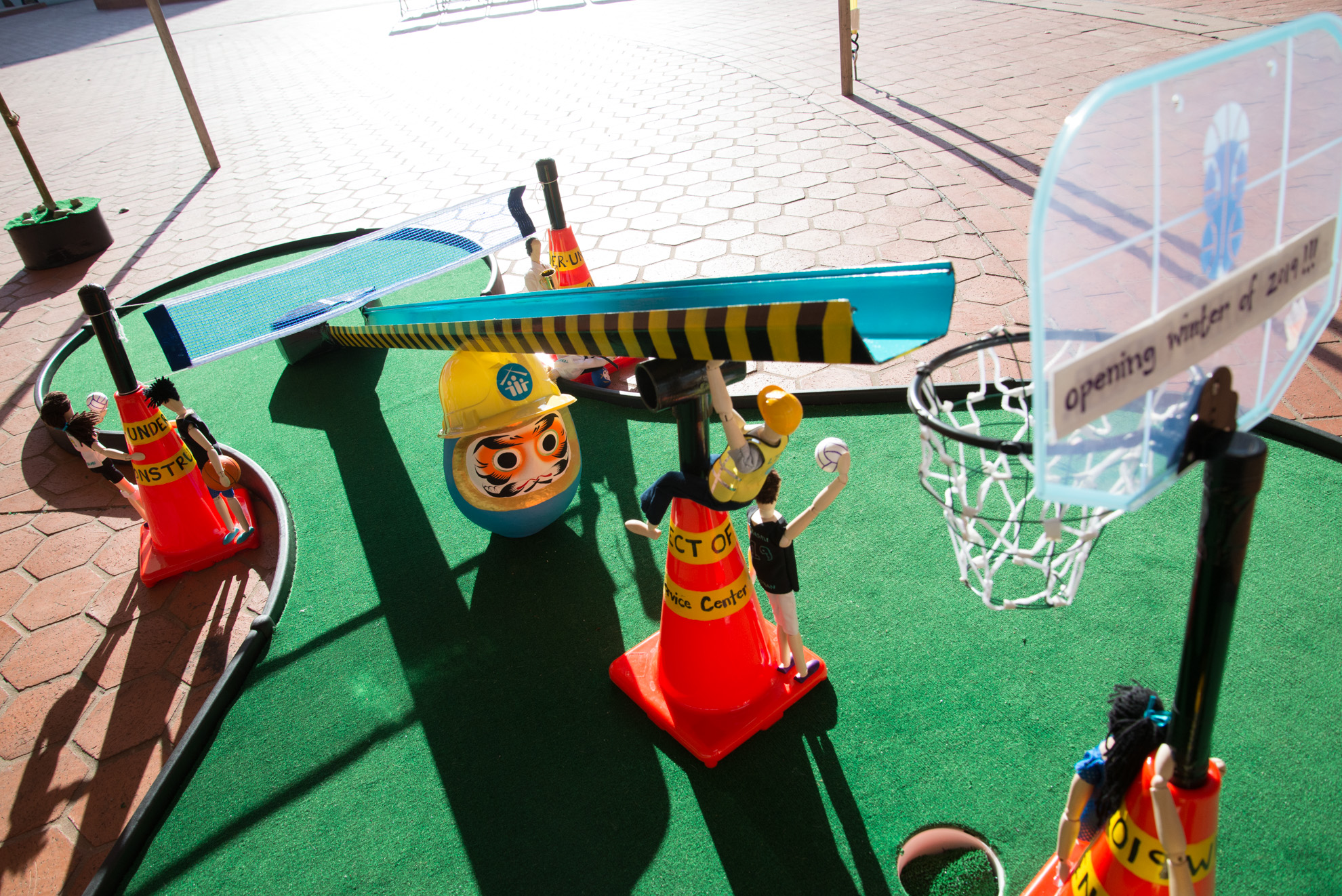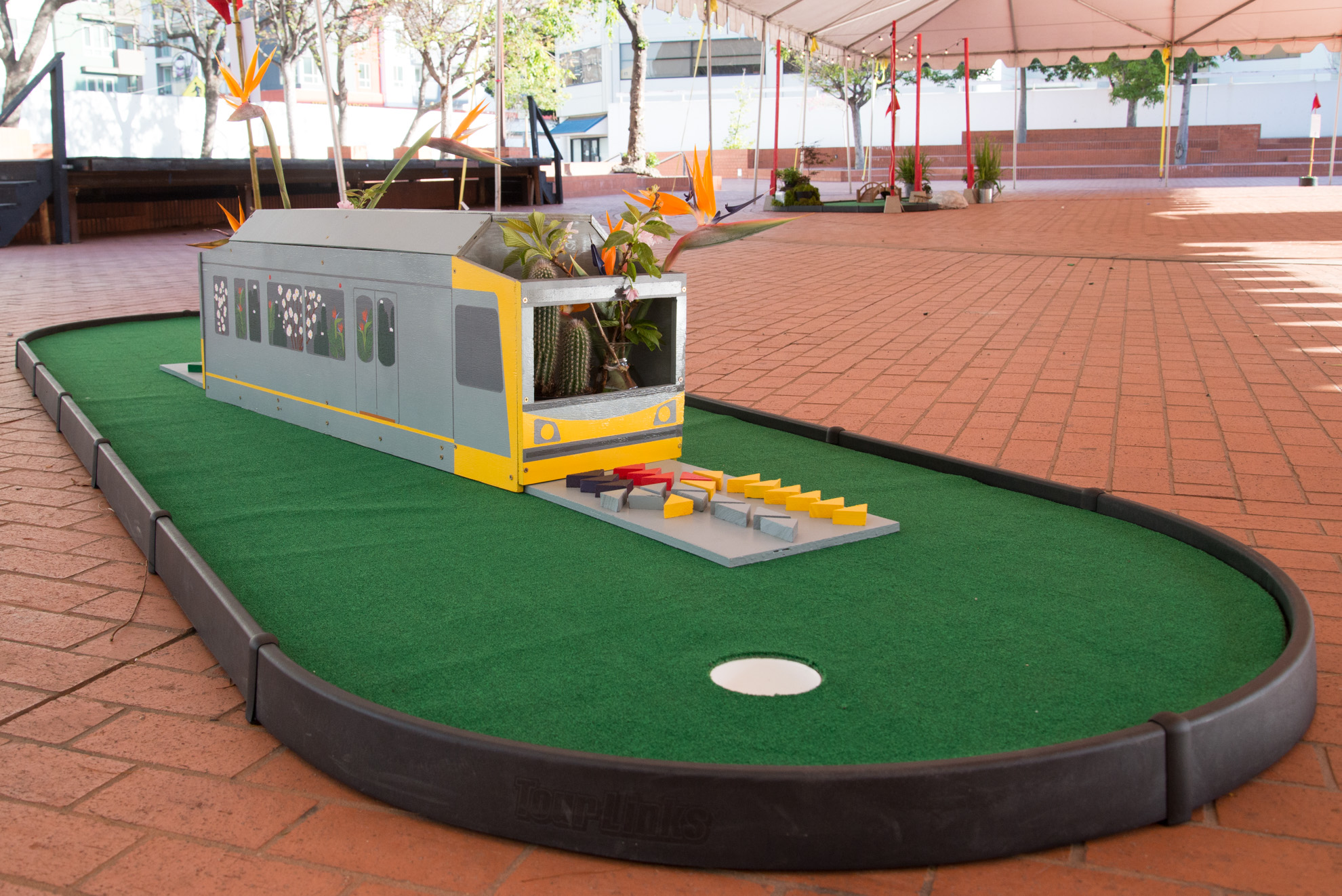



April 21–22 & 28–29, 2018
JACCC, 244 S. San Pedro Street
Visit, learn, explore, and play in Little Tokyo's 9-hole pop-up miniature golf course. Every hole is a vibrant artwork created by a local artist paying tribute to the past, present, and future of our 134-year old Japanese American community!
Artworks by:
Adina Mori-Holt & LTSC Terasaki Budokan
Andrea Aguilar
Brie Wakeland
Dan Kwong with Chris Tashima
Lina Cheng
MANO YA (Mario Correa & Zen Sekizawa)
Mei Zhao
A partnership with Little Tokyo Business Association, JACCC, and Sustainable Little Tokyo. Sponsored by Let's Play and LTBA.
ARTWORKS & ARTIST BIOS
ATOMIC CAFE & FUGETSU-DO MASTER
Andrea Aguilar
Both of Andrea's artworks speak to the history of Little Tokyo’s cultural legacies of music, visual art and working-class values that once existed or continue to exist in this neighborhood.
Atomic Cafe represents the proud rebellious past of the underground punk rock culture in the 1980’s. This hub, that began, in of all places, a Japanese American community, could not have existed in middle and upper class white communities, and was a result of restless youth seeking meaning and acceptance in an otherwise very ordinary working-class neighborhood. Unfortunately, this long-gone landmark was demolished for the construction of the Metro Regional Connector, but deserves a place of remembrance.
Fugetsu-Do Master, a sculpture of a man pounding mochi, may appear conventional as a representation of Japanese American culture, but illustrates the incredible communal effort needed to create mochi, and the work ethic that presently exist in Little Tokyo’s family owned-businesses, such as Fugetsu-Do, the neighborhood’s oldest operating business.
Andrea Aguilar: I am a 30-year-old art student attending Pasadena City College with the aim of transferring to Cal State Long Beach as a Drawing and Painting major. My interest and training started at an early age but was not seriously sparked and thoroughly trained until I was admitted into the Ryman Arts program in high school. At heart I am a multimedia artist, unafraid of tackling new challenges. My recent fight-for and friendship with the evictee artist-residents of 800 Traction allowed me to discover the underground art scene of the 1970’s, 80’s, and 90’s of the Arts District and the effect of the contributions of Japanese-Americans as a part of that art culture.
HOME COURT FOR ALL
Adina Mori-Holt & LTSC Terasaki Budokan

Our mini golf hole incorporates all the sports that will be featured at Terasaki Budokan: basketball, martial arts and volleyball. Terasaki Budokan is a nonprofit community-driven project of Little Tokyo Service Center. Our mission is to provide a facility in Downtown Los Angeles for youth, families and seniors that offers sports, community activities and opportunities to connect visitors to Japanese American culture and a vibrant, sustainable Little Tokyo. It is A Home Court for All that will connect future generations of Japanese Americans and Los Angelenos to Little Tokyo’s cultural heritage through sports and community activities. It is currently under construction on Los Angeles St (between 2nd and 3rd St) and will open late 2019. As a nonprofit project, Terasaki Budokan relies heavily on volunteers, donations and support from people like you! Please go to TerasakiBudokan.org to learn more about our project and how to get involved.
Adina Mori-Holt is a native Los Angeleno who grew up with many fond memories of Little Tokyo. Adina has a BA in Studio Art from Bates College (Lewiston, ME) and a MFA in Digital Photography/Video from Maryland Institute College of Art (Baltimore, MD). Adina coached volleyball for 10 years and has been a Budokan Project Volunteer since 2008 and a Budokan Communications/Development Assistant since 2016.
Little Tokyo Service Center is a nonprofit social service and community development organization committed to improving the lives of individuals and families through culturally sensitive social service care, strengthening our neighborhoods through housing and community development, and promoting the rich heritage of our ethnic communities.
TRANQUILITY GREEN
Brie Wakeland

My miniature golf hole pays respect to the JACCC James Irvine Japanese Garden. My interpretation would pay homage to the tranquility and natural beauty which can be found within Little Tokyo.
Brie Wakeland has lived in the DTLA area for ten years and Little Tokyo has always been one of her favorite neighborhoods within Los Angeles. She studied traditional sign painting at Los Angeles Trade Technical College and has been a working sign painter and chalkboard artist for over 3 years now. She also has experience as a mural artist. Each summer she works as an educator teaching children about art and gardening at the Los Angeles County Arboretum and Botanical Gardens. During the year she works within LAUSD elementary schools teaching gardening and culinary arts to low income children. Her experience as a professional gardening has given the knowledge and inspiration to create a Japanese garden miniature golf hole.
LT
Dan Kwong with Chris Tashima

LT is a visual abstraction of 1st, 2nd, and San Pedro Streets, and relevant geographical landmarks as seen from above. The artwork references: Japanese American incarceration camp; the crucial role of the 442 in moving the Japanese American community past the internment experience; LT's proximity to Boyle Heights and its history as a sister multicultural neighborhood; and the growing pains and disruption of Metro line construction. This hole simulates a conceptual trip through the heart of the Little Tokyo neighborhood from Union Church to the JACCC and, simultaneously, a journey from Japan to L.A. You have multiple options of fun routes, and we invite you to play the hole repeatedly—'cause the journey should be as interesting as the destination!
Dan Kwong is an award-winning multimedia artist involved in three major projects in Little Tokyo this year: the +LAB Little Tokyo Artist Residency; performing What? No Ping-Ping Balls? at JANM's Tateuchi Democracy Forum June 1–3, 2018; and the Little Tokyo Mini Open miniature golf course. Kwong is Resident Artist at 18th Street Arts Center and Associate Artistic Director for Great Leap. dankwong.com
DARUMA'S EYE
Lina Cheng

Daruma's Eye is my mini wonderland for Little Tokyo. To celebrate the community's rich culture and 134-year history, the course features: recreation of iconic sculptures and monuments (Yagura Tower, Friendship Knot, Oomo Cube), nods to some of my favorite spots to visit (Fugetsu-Do, Blue Whale Jazz Club), and traditional symbols like the daruma doll, which is intended to represent well wishes for Little Tokyo's future as well as a token of encouragement for mini-golfers to reach their goal and conquer the course!
Lina Cheng: As a kid, I focused on classical drawing and painting. Interests transofrmed and I pursued an education in design and media arts. Re-imagining objects and spaces that give a sense of wonder is my passion. Nowadays, if I'm not sitting in LA traffic, I'm making time for museums and creative exploration.
NOGUCHI'S MULLIGAN
MANO YA


MANO YA takes inspiration from the artist and designer of the JACCC Plaza, Isamu Noguchi. Noguchi voluntarily incarcerated himself at Poston War Relocation Center in response to Executive Order 9066. Noguchi proposed improvements to the bleak conditions, including a mini-golf course. He left within six months after realizing he had no support from the officials, and his artistic privilege alienated him from other internees.
Noguchi’s voluntary incarceration plays out as a cautionary tale about the relationship art and artists have to power. As artists, we have great admiration for Noguchi’s gesture and equal empathy for the shortcoming of his vision. What affect would his redesigned camp have had were it fully realized? What would the mini-golf course have looked like? Noguchi’s time in Poston delineates an aesthetic shift in his work: wood was the most available in camp, and his forms took on a more abstract and modern language, developing into the style he is known for today. With Noguchi’s experience and formalism in mind, Mano Ya will make a pair of miniature golf holes that reflect the precarious position of his action.
MANO YA is a custom object and furniture shop that represents the collaboration between Los Angeles artists Mario Correa and Zen Sekizawa. The MANO YA woodshop and studio, integrates fine art media, design and classic woodworking techniques; MANO YA is especially inspired by Mexican and Japanese cultural traditions in these fields. MANO means hand in Spanish, and YA, in Japanese, means shop.
BLOOMCITIVITY
Mei Zhao

Bloomcitivity represents the recent Metro Gold Line train and upcoming Regional Connector, connecting the present and future. The growth of our present trains helps with transportation around Los Angeles, California. This is a great opportunity to make the environment a greener place by using public transportation to commute to work. In addition, it will provide access to the various forms of art, music, culture, and food around the neighborhood. The painted windows of the train will portray multi-ethnic themes within the community.
Mei Zhao: I am Chinese American and I was born in Columbus, Ohio and then raised in Los Angeles, California since the age of 3. My connection to Little Tokyo is always passing through it often while riding my bicycle. Another form of transportation I have taken is the train to Little Tokyo Gold Line Station and it was through the train that I was able to explore their history on plaques in front of restaurants and businesses. Along with the public art pieces placed in Little Tokyo, they provide unity from the Friendship Knot to historic statues.